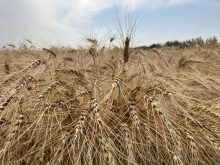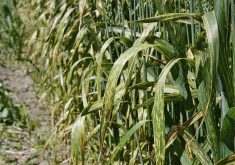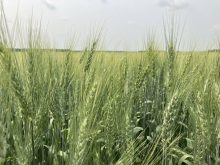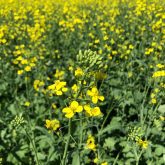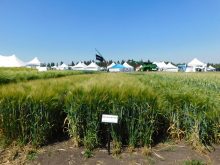Call it an agronomic mystery.
It’s been proven time and time again that, barring unforeseen challenges, the more seeds planted, the more crop harvested.
But those aren’t the results the Alberta Grains Plot2Farm program has seen in its field-scale trials on spring wheat.
Read Also

Moo translator and methane measures: There’s an app for that
Dalhousie University researchers use artificial intelligence to create new dairy farm apps that analyze cattle sounds and measure methane.
Four years of field trials have consistently shown that increasing seeding rates for wheat had little impact on yield and quality. It’s frustrating for agronomist Jeremy Boychyn, who knows that’s not been the case in small plot scenarios.
“Seeding rate trials specifically are not showing significant differences on a field scale,” he said.
“Historical seeding rate trials demonstrate that increasing seeding rates reliably increases yield, yield stability and other beneficial agronomic considerations.
“This does not expand to all small plot research as that information has not been investigated.”
But whatever you do, don’t seed less, said Boychyn, director of agronomy and extension for Alberta Grains at the organization’s regional meeting in Morinville.
High seeding rates introduce more competition into the underground survival-of-the-fittest contest where seeds compete with each other. Those most likely to grow into plants come out on top, he said.
“It seems counterintuitive, but the more seeds you put in that seed row, you’re creating that intra-plant competition, so whichever’s the strongest, the best, the highest yield potential in those tough conditions is going to beat out the other ones. So what you’re left with is the best of the best.
“And you can really only get there by creating that competition by increasing the seeding rates in those seed rows and creating that plant competition.”
That said, the trend has hampered the goals of this particular project, said Boychyn.
“It would be nice to expand the range of seeding rates we’re working with. Where do we start to see that drop? What do those plant stands look like? Because if I’m not seeing differences there, the question in my mind is are we seeding higher than the maximum potential already?”

Plot2Farm is a field-scale research program in which farmers themselves conduct on-farm trials with the assistance of Alberta Grains staff, who ensure proper research protocols are employed.
The trials are randomized and replicated, said Boychyn.
“What I mean by that is, if we’re looking at three different seeding rates, we’re implementing those three different seeding rates four times across the field so we are getting multiple data points on the same question. It’s randomized in that the order in which we put those treatments changes in each replication.
“So we have very strong data to work with when we come back and share that data with you.”
The trial Boychyn reported on — increasing seeding rates on spring wheat — took place near Claresholm in 2023 using the popular spring wheat variety AAC Brandon.
Treatments were seeded at 80, 96 and 110 pounds per acre with a 30 gram per thousand kernel weight, a 98 per cent germination rate and an assumed mortality of six to seven per cent.
In other words, the seeding rates to target 25, 30 and 35 plants per square foot were 27.1, 32.6, and 38 seeds per square foot, respectively.
Yield was not “statistically significant” among the three targeted plant stands. Twenty-five plants per square foot yielded 37.7 bushels per acre (bpa), 30 drove 38.5 bpa and the 35 target resulted in a yield of 38.1 bpa.
The plant stands themselves met the statistically significant benchmark, albeit coming short of expectations. The targeted plant stands of 25, 30 and 35 plants per acre resulted in 20.4, 24.8 and 29.3 plants per acre respectively –- 80 per cent of the target.
“We were about five plants short per treatment and that has to do with the poor seeding and germination conditions of the trial,” said Boychyn.
“However, we still got significant differences between treatments. There was still about five plants per square foot gap between treatments.”
Two other metrics — protein percentage (a measurement of wheat quality) and test weight (a measurement of density) — also produced statistically insignificant results.
Only 5.3 inches of rain were recorded between May and August inclusive, but moisture shortage doesn’t tell the whole story.
Boychyn pointed to a pre-drought field-scale trial that also revealed few differences between seeding rate treatments in spite of much better moisture conditions.
“We did do one spring wheat trial and one barley trial in 2020 in Carstairs with around 11, 12, 13 inches of rainfall, give or take, with 10 per cent organic matter. And still nothing.”
An attendee asked Boychyn if weeds were the problem. He didn’t think so.
“That’s one of the reasons to get higher seeding rates: to provide some extra competition for weeds. To my understanding, this was a relatively weed-free field.”




